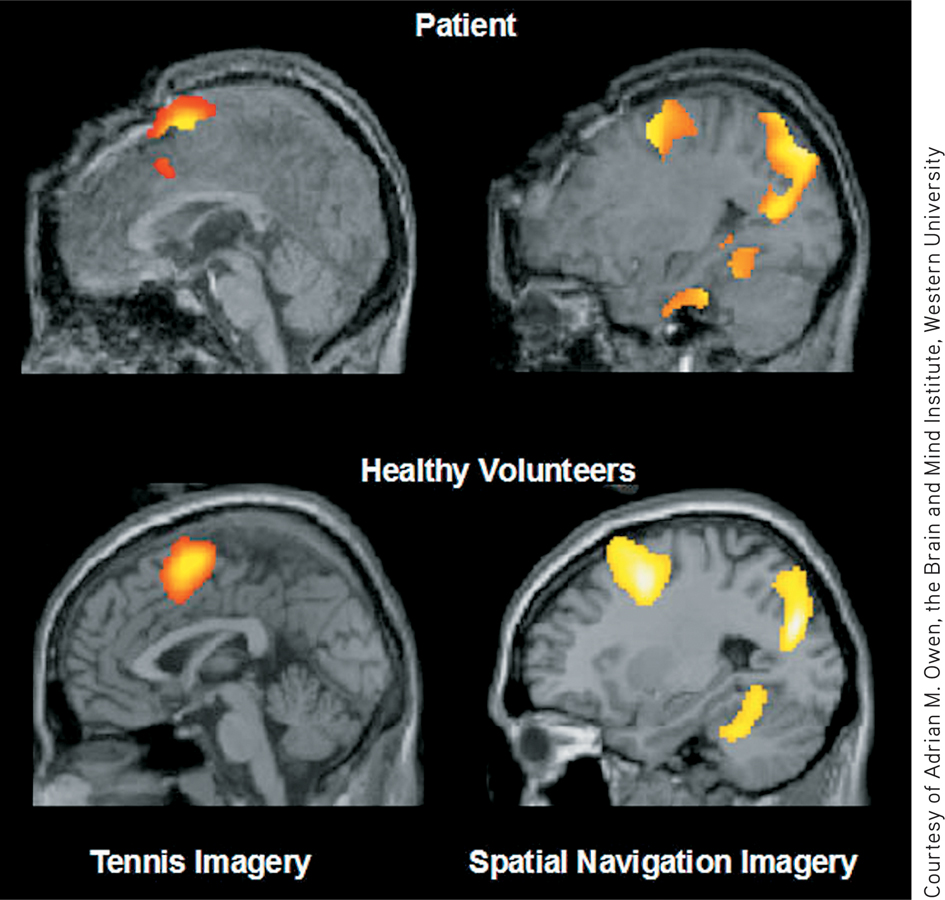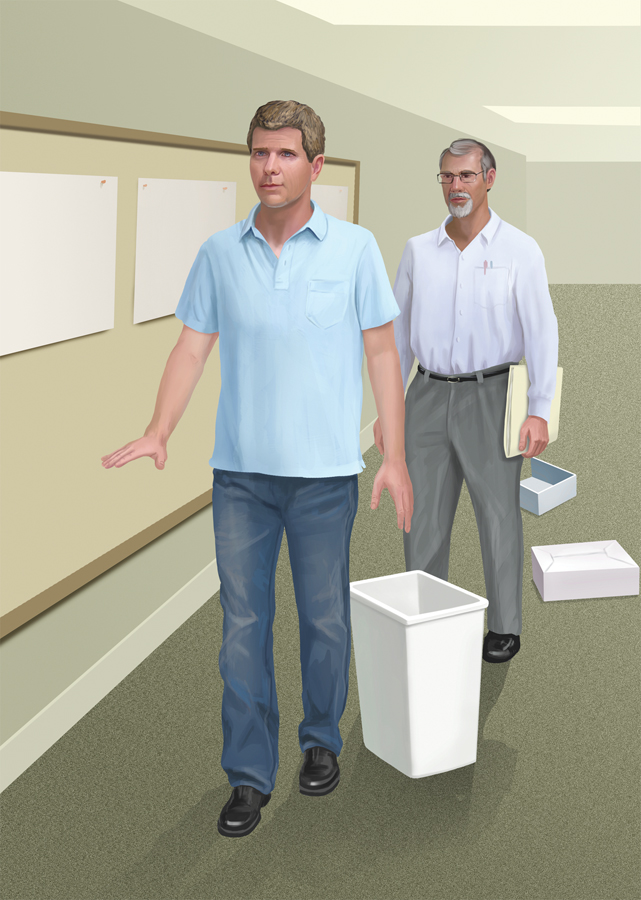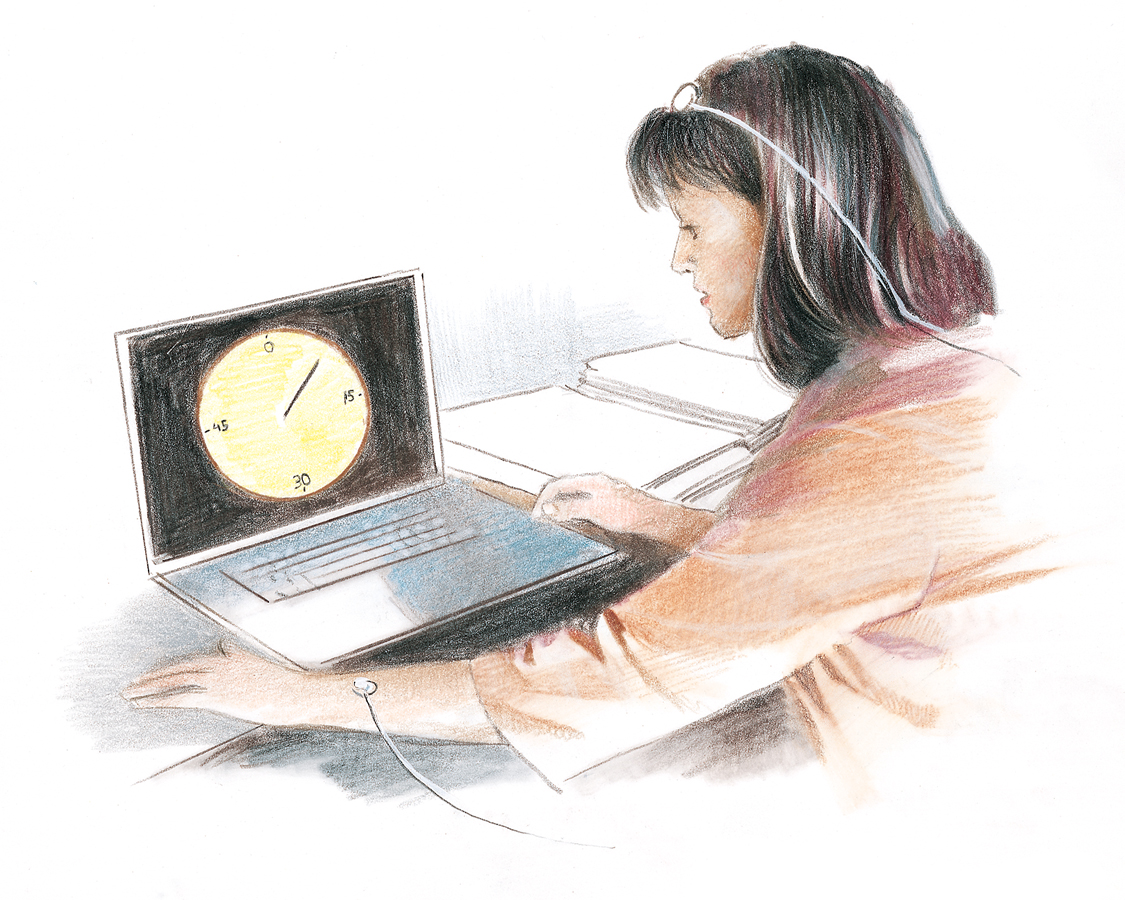8.2 The Biology of Consciousness
8-2 What is the “dual processing” being revealed by today’s cognitive neuroscience?
Cognitive Neuroscience
Scientists assume, in the words of neuroscientist Marvin Minsky (1986, p. 287), that “the mind is what the brain does.” We just don’t know how it does it. Even with all the world’s technology, we still don’t have a clue how to make a conscious robot. Yet today’s cognitive neuroscience—the interdisciplinary study of the brain activity linked with our mental processes—is relating specific brain states to conscious experiences.
A stunning demonstration of consciousness appeared in brain scans of a noncommunicative patient—a 23-year-old woman who had been in a car accident and showed no outward signs of conscious awareness (Owen, 2014; Owen et al., 2006). When researchers asked her to imagine playing tennis, fMRI scans revealed activity in a brain area that normally controls arm and leg movements (FIGURE 8.2). Even in a motionless body, the researchers concluded, the brain—and the mind—may still be active. A follow-up analysis of 42 behaviorally unresponsive patients revealed 13 more who also showed meaningful, though less than normal, brain responses to questions (Stender et al., 2014). But reanalysis of some of these EEG data found the positive results to be mere muscle twitches (Goldfine et al., 2013). So this research is an unfinished story.

 Figure 8.2
Figure 8.2Evidence of awareness? When asked to imagine playing tennis or navigating her home, a vegetative patient’s brain (top) exhibited activity similar to a healthy person’s brain (bottom). Researchers wonder if such fMRI scans might enable a “conversation” with some unresponsive patients, by instructing them, for example, to answer yes to a question by imagining playing tennis (top and bottom left), and no by imagining walking around their home (top and bottom right).
Many cognitive neuroscientists are exploring and mapping the conscious functions of the cortex. Based on your cortical activation patterns, they can now, in limited ways, read your mind (Bor, 2010). They could, for example, tell which of 10 similar objects (hammer, drill, and so forth) you were viewing (Shinkareva et al., 2008).
Some neuroscientists believe that conscious experience arises from synchronized activity across the brain (Gaillard et al., 2009; Koch & Greenfield, 2007; Schurger et al., 2010). If a stimulus activates enough brain-wide coordinated neural activity—with strong signals in one brain area triggering activity elsewhere—it crosses a threshold for consciousness. A weaker stimulus—perhaps a word flashed too briefly to consciously perceive—may trigger localized visual cortex activity that quickly fades. A stronger stimulus will engage other brain areas, such as those involved with language, attention, and memory. Such reverberating activity (detected by brain scans) is a telltale sign of conscious awareness (Boly et al., 2011). How the synchronized activity produces awareness—how matter makes mind—remains a mystery.
RETRIEVAL PRACTICE
- Those working in the interdisciplinary field called ___________ ___________ study the brain activity associated with perception, thinking, memory, and language.
cognitive neuroscience
Dual Processing: The Two-Track Mind
Many cognitive neuroscience discoveries tell us of a particular brain region that becomes active with a particular conscious experience. Such findings strike many people as interesting but not mind blowing. (If everything psychological is simultaneously biological, then our ideas, emotions, and spirituality must all, somehow, be embodied.) What is mind blowing to many of us is the growing evidence that we have, so to speak, two minds, each supported by its own neural equipment.
At any moment, you and I are aware of little more than what’s on the screen of our consciousness. But beneath the surface, unconscious information processing occurs simultaneously on many parallel tracks. When we look at a bird flying, we are consciously aware of the result of our cognitive processing (“It’s a hummingbird!”) but not of our subprocessing of the bird’s color, form, movement, and distance. One of the grand ideas of recent cognitive neuroscience is that much of our brain work occurs off stage, out of sight. Perception, memory, thinking, language, and attitudes all operate on two levels—a conscious, deliberate “high road” and an unconscious, automatic “low road.” The high road is reflective, the low road is intuitive (Evans & Stanovich, 2013; Kahneman, 2011). Today’s researchers call this dual processing. We know more than we know we know.
If you are a driver, consider how you move to the right lane. Drivers know this unconsciously but cannot accurately explain it (Eagleman, 2011). Most say they would bank to the right, then straighten out—a procedure that would actually steer them off the road. In reality, an experienced driver, after moving right, automatically reverses the steering wheel just as far to the left of center, and only then returns to the center position. The lesson: The human brain is a device for converting conscious into unconscious knowledge.
Or consider this story, which illustrates how science can be stranger than science fiction. During my sojourns at Scotland’s University of St. Andrews, I [DM] came to know cognitive neuroscientists David Milner and Melvyn Goodale (2008). A local woman, whom they call D.F., suffered brain damage when overcome by carbon monoxide, leaving her unable to recognize and discriminate objects visually. Consciously, D.F. could see nothing. Yet she exhibited blindsight—she acted as though she could see. Asked to slip a postcard into a vertical or horizontal mail slot, she could do so without error. Asked the width of a block in front of her, she was at a loss, but she could grasp it with just the right finger–thumb distance. Likewise, if your right and left eyes view different scenes, you will only be consciously aware of one at a time. Yet you will display some blindsight awareness of the other (Baker & Cass, 2013).
How could this be? Don’t we have one visual system? Goodale and Milner knew from animal research that the eye sends information simultaneously to different brain areas, which support different tasks (Weiskrantz, 2009, 2010). Sure enough, a scan of D.F.’s brain activity revealed normal activity in the area concerned with reaching for, grasping, and navigating objects, but damage in the area concerned with consciously recognizing objects.1 (See another example in FIGURE 8.3)

 Figure 8.3
Figure 8.3When the blind can “see” In this compelling demonstration of blindsight and the two-track mind, researcher Lawrence Weiskrantz trailed a blind-sight patient down a cluttered hallway. Although told the hallway was empty, the patient meandered around all the obstacles without any awareness of them.
How strangely intricate is this thing we call vision, conclude Goodale and Milner in their aptly titled book, Sight Unseen. We may think of our vision as a single system that controls our visually guided actions. Actually, it is a dual-processing system. A visual perception track enables us “to think about the world”—to recognize things and to plan future actions. A visual action track guides our moment-to-moment movements. Some scientists have questioned whether blindsight patients are utterly without conscious vision (Himmelbach et al., 2012; Overgaard, 2012). But the big idea—that human perceptions, memories, thinking, language, and attitudes operate on both conscious and unconscious levels—stands as one of the great insights of today’s cognitive neuroscience.
The dual-track mind also appears in a patient who lost all of his left visual cortex, leaving him blind to objects and faces presented on the right side of his field of vision. He nevertheless can sense the emotion expressed in faces, which he does not consciously perceive (De Gelder, 2010). The same is true of normally sighted people whose visual cortex has been disabled with magnetic stimulation. Such findings suggest that brain areas below the cortex are processing emotion-related information.
People often have trouble accepting that much of our everyday thinking, feeling, and acting operates outside our conscious awareness (Bargh & Chartrand, 1999). We are understandably biased to believe that our intentions and deliberate choices rule our lives. But consciousness, though enabling us to exert voluntary control and to communicate our mental states to others, is but the tip of the information-processing iceberg. Being intensely focused on an activity (such as reading this module, we’d love to think) increases your total brain activity no more than 5 percent above its baseline rate. And even when you rest, “hubs of dark energy” are whirling inside your head (Raichle, 2010).
Here’s another weird (and provocative) finding: Experiments show that when you move your wrist at will, you consciously experience the decision to move it about 0.2 seconds before the actual movement (Libet, 1985, 2004). No surprise there. But your brain waves jump about 0.35 seconds before you consciously perceive your decision to move (FIGURE 8.4)! The startling conclusion: Consciousness sometimes arrives late to the decision-making party.

 Figure 8.4
Figure 8.4Is the brain ahead of the mind? In this study, volunteers watched a computer clock sweep through a full revolution every 2.56 seconds. They noted the time at which they decided to move their wrist. About one-third of a second before that decision, their brain-wave activity jumped, indicating a readiness potential to move. Watching a slow-motion replay, the researchers were able to predict when a person was about to decide to move (following which, the wrist did move) (Libet, 1985, 2004). Other researchers, however, question the clock measurement procedure (Miller et al., 2011).
That inference has triggered more research and much debate. Does our brain really make decisions before we know about them? If so, is free will an illusion? Using fMRI scans, EEG recordings, or implanted electrodes, some studies seem to confirm that brain activity precedes—and helps predict—people’s decisions to press a button or to choose a card in a simplified poker game (Carter et al., 2012; Fried et al., 2011; Soon et al., 2008). However, other studies indicate that brain activity continuously ebbs and flows, including during the experiments’ predecision phase—regardless of whether the decision is made and executed (Schurger et al., 2012). The actual decision to move occurs when the brain activity crosses a threshold, which happens to coincide with the average “time of awareness of intention to move” (about 0.15 second before the movement). This view sees the mind’s decision and the brain’s activity, like a computer’s problem solving and its electronic activity, as simultaneous and parallel.
 To think further about the implications of these provocative findings for our understanding of free will and decision making, visit LaunchPad’s PsychSim 6: Who’s in Charge?
To think further about the implications of these provocative findings for our understanding of free will and decision making, visit LaunchPad’s PsychSim 6: Who’s in Charge?
Running on automatic pilot allows our consciousness—our mind’s CEO—to monitor the whole system and deal with new challenges, while neural assistants automatically take care of routine business. A skilled tennis player’s brain and body respond automatically to an oncoming serve before becoming consciously aware of the ball’s trajectory (which takes about three-tenths of a second). Ditto for other skilled athletes, for whom action precedes awareness. The bottom line: In everyday life, we mostly function like an automatic camera, but with a manual (conscious) override.
Great myths often engage simple pairs: good Cinderella and the evil stepmother, the slow Tortoise and fast Hare, the logical Sherlock Holmes and emotional Dr. Watson. The myths have enduring power because they express our human reality. Dualities are us.
RETRIEVAL PRACTICE
- What are the mind’s two tracks, and what is “dual processing”?
Our mind has separate conscious and unconscious tracks that perform dual processing–organizing and interpreting information simultaneously.